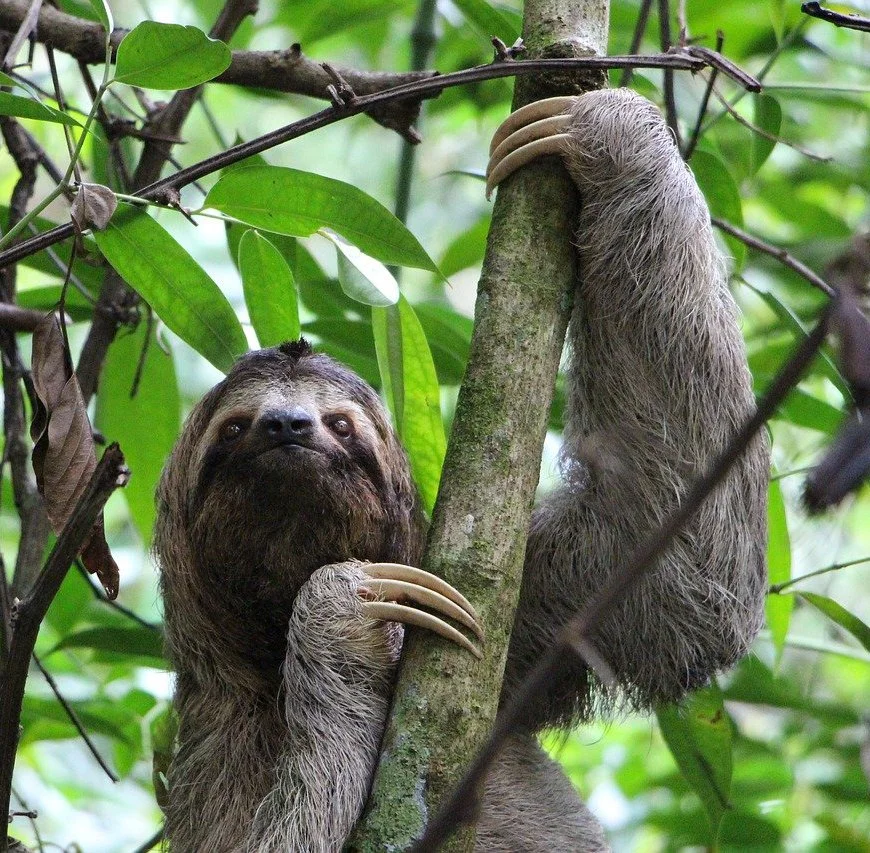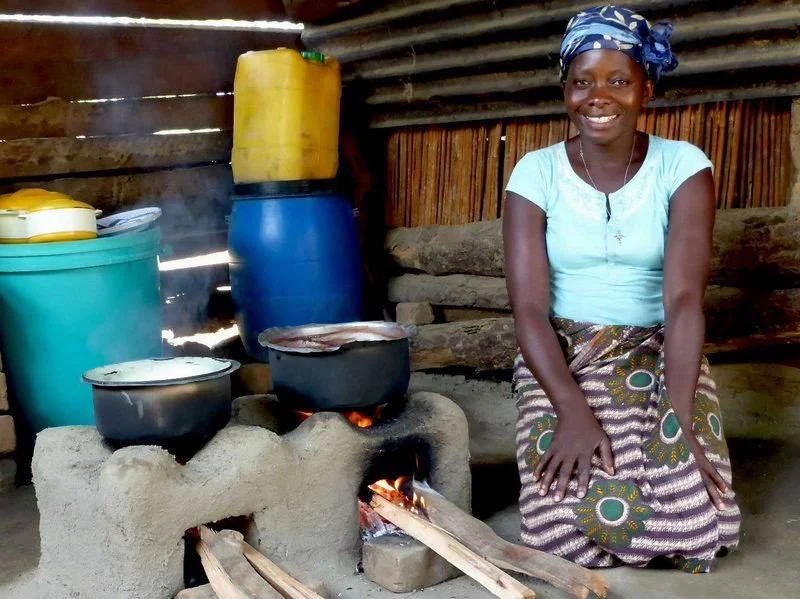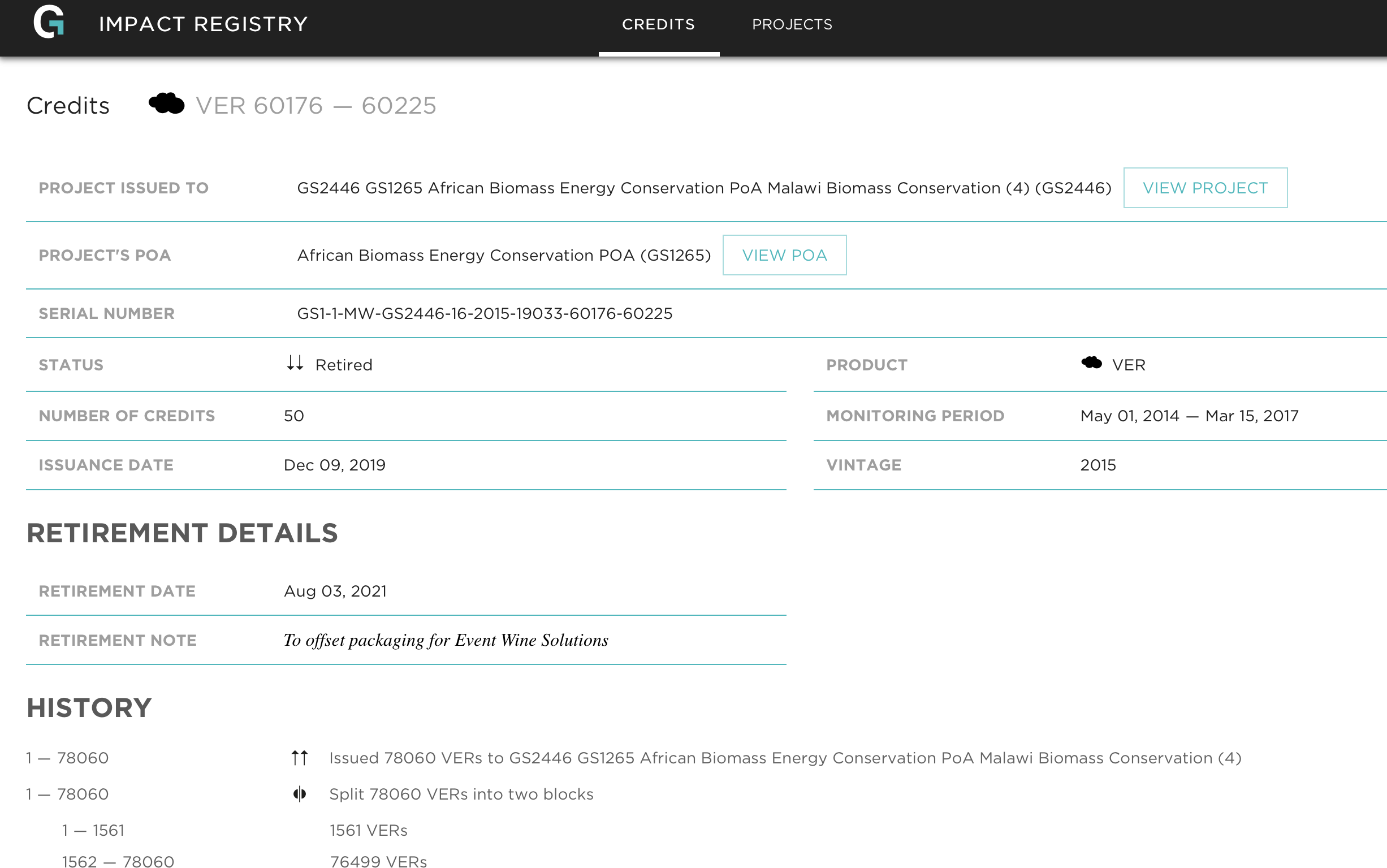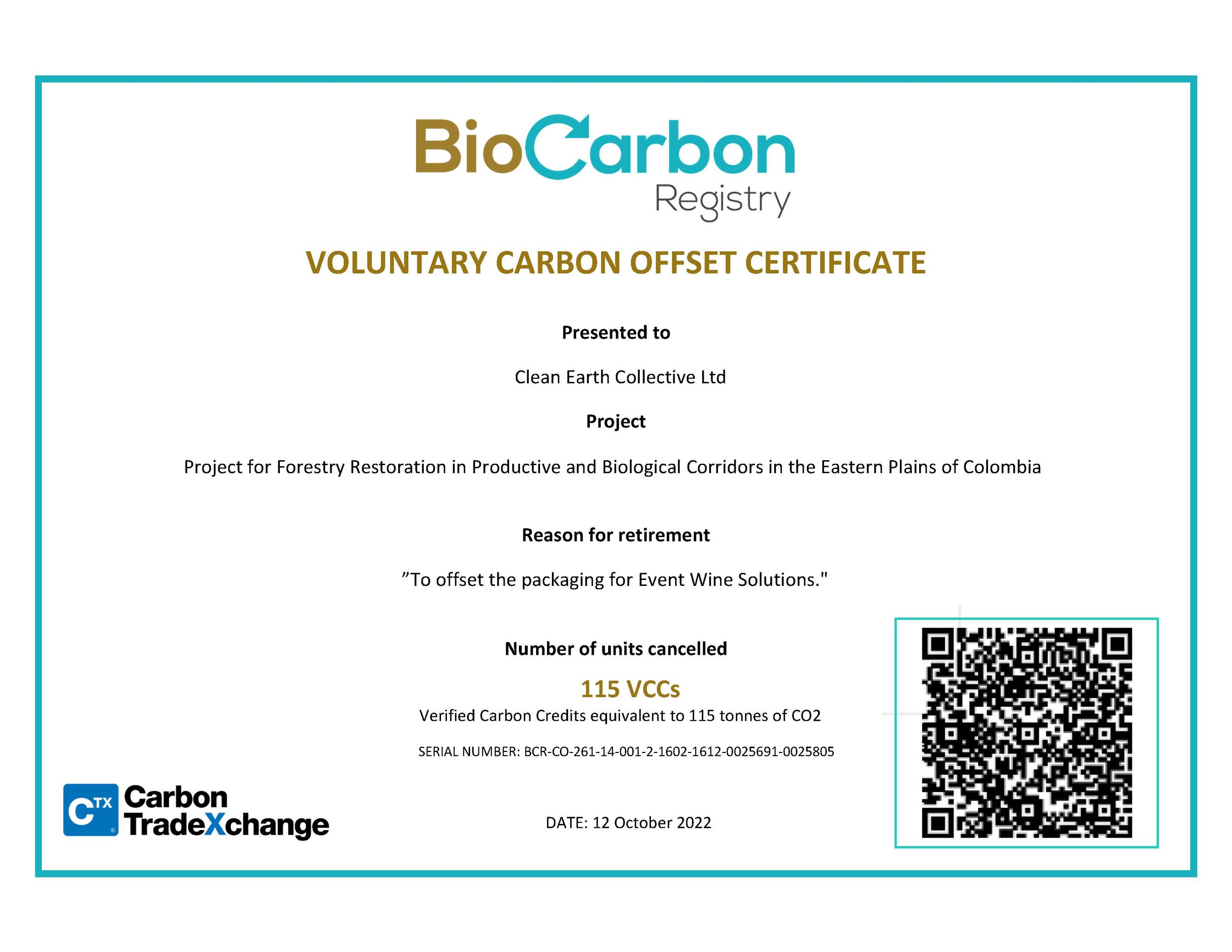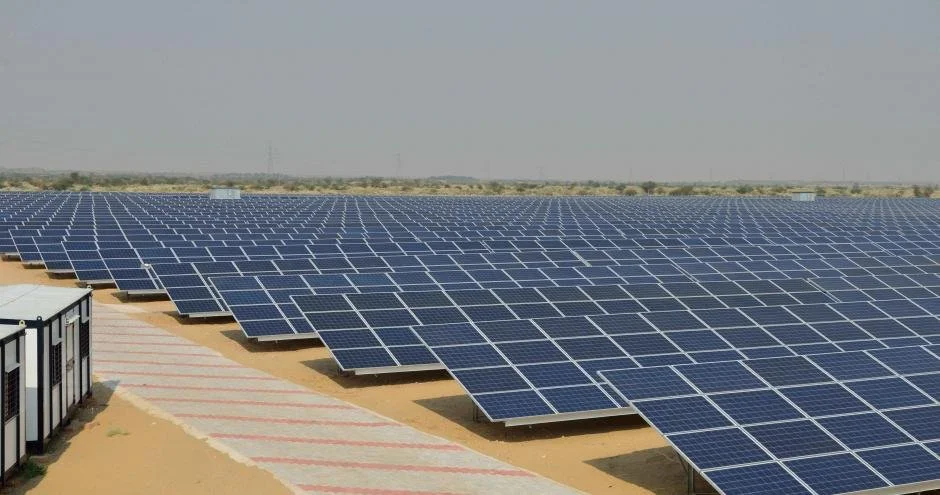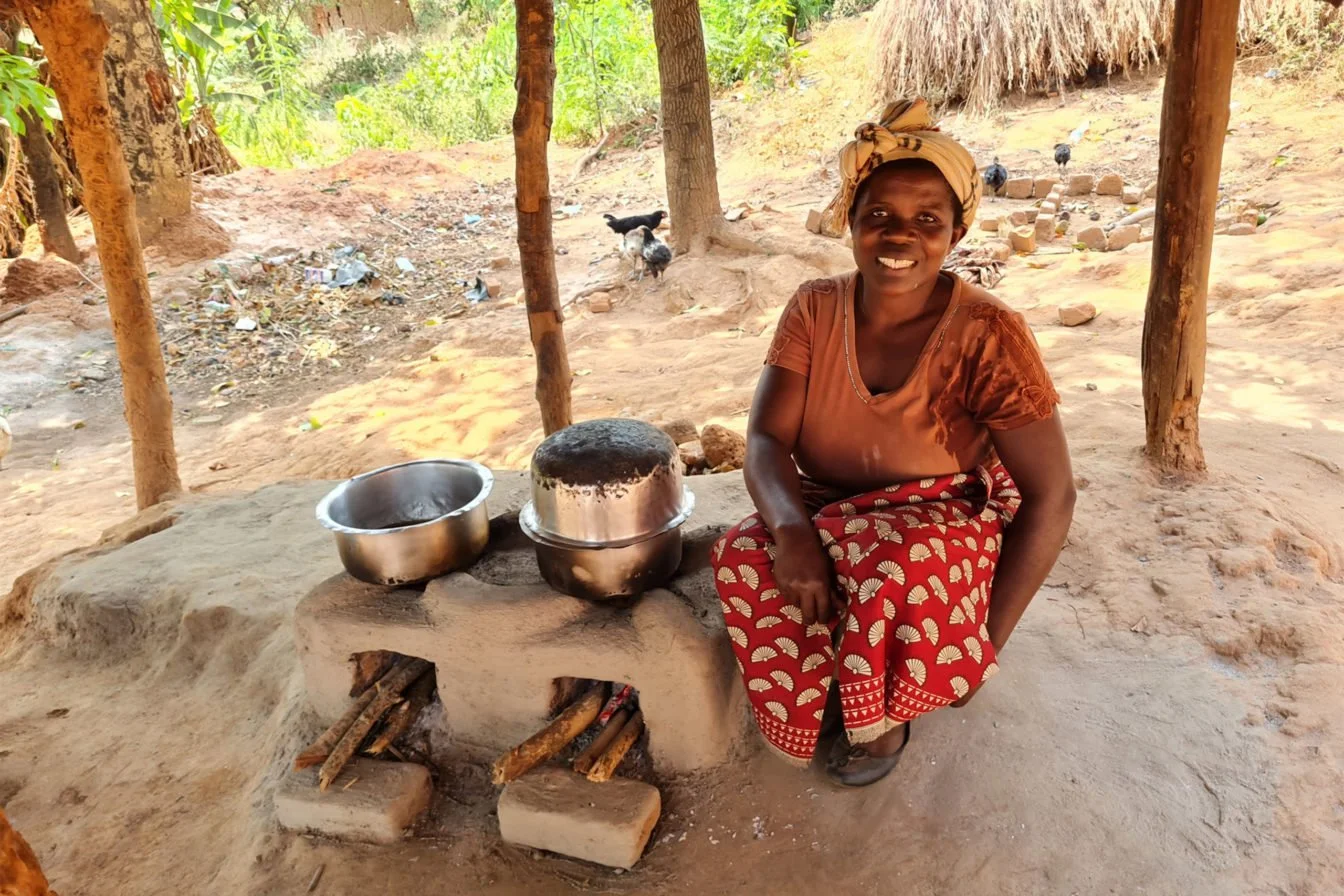Carbon neutral packaging
We are proud to be working with The Clean Earth Collective to offset all the carbon emissions of our wine packaging (rPET bottles, caps, labels and cartons). Our ultimate aim is to become a carbon negative business and we are working to achieve this in the coming years.
How does it work?
Our packaging volumes and data are analysed by the CEC and carbon (CO2e) conversion factors are applied to each material to calculate the embodied carbon emissions of the bottle and packaging, the total tonnes of carbon (CO2e) emissions are then calculated for each production. Each metric tonne of carbon (CO2e) is equivalent to one carbon credit. Event Wine Solutions will then purchase the corresponding volume of credits from a range of sustainable projects to match our packaging emissions.
About The Clean Earth Collective
The Clean Earth Collective offers organisations the opportunity to offset emissions transparently, ethically, and competitively. Helping them to achieve alignment with the Paris Accord and to go above and beyond business and become Climate Positive. The Clean Earth Collective sources ethical carbon credits which fund a range of exciting projects – see below for the projects we have invested in.
Forestry Conservation Project
Madre de Dios, Peru
VCS01067
Carbon Credit Type: VCS
Validated by the Rainforest Alliance
The Clean Earth Collective is currently supporting a forestry and conservation project in Peru with the Rainforest Alliance. The project has been developed in the area comprised by Tambopata National Reserve and the sector of Bahuaja-Sonene National Park located in Madre de Dios region. The aim of the project is to conserve forests from both NPAs against the imminent advance of deforestation. More project Information >
Cookstove Project
Malawi
GS 002446
Project Type: Energy Efficiency
This project involves the distribution of energy efficient cook stoves around Malawi. Many households are still relying on open fires to cook and purify water. This project aims on improving / lessening the natural energy requirements of as many communities as possible through the efficiency of the design. It is one of the most cost effective ways of improving the lifestyle and sustainable development of the many communities in the region as possible.
Primary objectives
1. To lessen the impact on the natural environment and demand for wood and associated carbon (CO2e) emissions, whilst also freeing up time for innovation, and contributing towards a sensitive approach towards proactive development.
2. To address and improve the localised air quality for each household.
These stoves have been designed to utilise efficient rocket technology and will be manufactured, distributed and installed by local people. Initial testing has shown these stoves to be more than 50% more efficient than traditional models as well as it reduces the indoor smoke about 80%. These stoves will be using less firewood and emitting less smoke.
Climate change and health are inexorably linked. The WHO estimates that 7 million premature deaths annually are linked to air pollution and between 2030 and 2050 climate change is expected to cause approximately 250,000 additional deaths per year, with direct damage costs to health estimated at between US$2-4 billion/ year by 2030. If climate change is not brought under control, health problems from unclean air, major depletion of natural resources, water unsafe to drink, insufficient food and lack of secure shelter will only be exacerbated, leaving those developing countries that are most exposed least able to cope.
Stable Farming Environments:
• Project stoves save up to 80% firewood compared to an open fire.
• Households can save on average 1 tonne of wood per year.
• With less firewood demand, there is also less pressure on the local natural environment which can result in reduced soil erosion.
• Biodiversity and forest resources are enhanced and local farming benefits greatly.
• Stoves will be built locally in the surrounding area.
• Greatly reduces the amount of time needed to gather sufficient wood.
Safer childhoods
The vast majority of hospitalised burn victims in Africa are under the age of six years old. Hot liquid scalds and open flame burns are the most common type of injury. The project’s improved cookstoves are safer than traditional cooking methods because the stove’s structure shields the fire to contain heat and so protects against burns.
Air pollution
The World Health Organisation reports that household air pollution is the number one risk factor for burden of diseases. Improved cookstoves are associated with reduced smoke, which can lessen exposure to indoor air pollution, reduce asthma, long term respiratory problems and generally improve immune system health.
Download project document >
Conservation projects
Geothermal Project
El Salvador
CDM00297
Purpose and general description of project activity: The primary objective of the Project Activity is to supply El Salvador’s rising demand for energy due to economic growth and to improve the supply of electricity, while contributing to the environmental, social and economic sustainability by increasing renewable energy’s share of total the Salvadoran electricity consumption. One fundamental goal of the project is the efficient use of resources, particularly indigenous resources, while minimising impact on the environment.
Contribution to Sustainable Development: The use of an indigenous and cleaner source of electricity will also contribute to environmental sustainability by avoiding electricity generation from imported fossil fuel sources – and reducing the emissions of greenhouse gases (GHG) – which would be generated in the absence of the project. The estimate of total annual average GHG emission reductions for the second crediting period is 150,171 tCO2e. A better income distribution in the region where the Project Activity is carried out will come from less expenditure and more income in local municipalities. The additional regional income may be used for providing the population with better services, which would improve the coverage of basic needs. The project is in line with the national sustainable energy strategies and climate change mitigation principles (from MARN, 1999, “sustainable exploration of geothermal and hydro resources”). This is the one of the reasons why the project has received all needed government support and endorsement regarding the participation in the CDM since the phase of feasibility study. Economical and/or strategic benefits include the decrease in dependence on fossil fuels, an exogenous and environmentally unsustainable source of energy. The Project Activity includes a biodiversity inventory research project to be done by the National University of El Salvador and a conservation and reforestation program in areas surrounding the plant. The Berlin Geothermal Power Plant also has a community engagement program aimed to create a balanced and constructive environment with neighbouring municipalities of Berlin. The fundamental elements of the program, used to maximise benefits to the community, are the generation of local employment opportunities, social investment activities, development of sustainable small businesses, and protection of the local environment. An indirect benefit is the construction and maintenance of road infrastructure that ensures communication and commercial activities in the surroundings of the project site.
Solar Power Project
Bhadla, Rajasthan
GS7071
The purpose of the project activity is to generate power using renewable energy source (solar energy) and sell the power generated to the state grid. The project activity generates electricity using solar energy. The generated electricity is exported to the regional grid system which is under the purview of the INDIAN electricity grid of India. The project activity replaces anthropogenic emissions of greenhouse gases estimated to be approximately 694,471 tCO2e per year, thereon displacing 732,874 MWh/year amount of electricity from the generation mix of power plants connected to the INDIAN GRID, which is mainly dominated by thermal/ fossil fuel based power plant.
Wind Power Project
Orosi, Costa Rica
GS7071
Project Type: Renewable Energy
Carbon Credit Type: CDM, approved by the UNFCCC
Hydroelectric power plants are Costa Rica’s principal source of clean energy. In addition, at a smaller scale, use is made of solar, biomass, geothermal and increasingly wind energy. But not all energy generation in Costa Rica is clean: until recently, it had to switch during dry periods to the use of fossil fuelled energy sources. This left the country dependent on the imports of fossil fuels, and that’s what Costa Rica wanted to depart from, especially when nature offers more interesting alternatives. It meant that diversification of its clean energy generation capacity was needed as dry periods will continue to occur and hydroelectric power stations cannot continue during long periods of drought. In the case of Costa Rica it is wind energy which provides an excellent alternative energy source as the wind always blows in major parts of the country.
The wind speed in the sparsely populated province Guanacaste is exceptionally high and stable. Since 2013 25 turbines have been installed, transmission lines have been pulled and related infrastructure has been built. For the trees that had to be felled, a reforestation program started. It provided for replanting of a tenfold of the number of felled trees. At the bottom line, the project emits approximately 76,532 tCO2eq per year less then a non-renewable energy plant would have emitted to produce the same quantity of energy.
Now the wind farm supplies enough energy for approximately 100,000 Costa Ricans. Wind farms such as Orosí offer the country a strategic and sustainable alternative and moreover a good diversification of the energy mix. In 2015, 99% of the production of electricity in Costa Rica was sustainable, of which at least 250 days completely run on renewable energy. The country is worldwide viewed as a true leader. Their ambitions will be achieved as the various clean sources of energy can be used now and for many years to come. This is made possible with the right kind of long-term financing.
The purpose of the project activity is to generate power using renewable energy source (solar energy) and sell the power generated to the state grid. The project activity generates electricity using solar energy. The generated electricity is exported to the regional grid system which is under the purview of the INDIAN electricity grid of India. The project activity replaces anthropogenic emissions of greenhouse gases estimated to be approximately 694,471 tCO2e per year, thereon displacing 732,874 MWh/year amount of electricity from the generation mix of power plants connected to the INDIAN GRID, which is mainly dominated by thermal/ fossil fuel based power plant.
Tree Planting Project
Colombia
Project ID: BCR-CO-261-14-001
This project is based on changing the use of land from extensive cattle ranching to sustainable forest production systems, restoring natural forest cover, and creating a landscape of biological corridors and conservation areas that will protect wildlife and biodiversity. The funds will contribute to sustainable infrastructure, help combat climate change through sustainable forestry, regulate water flows, promote expansion of habitat, and protect the flora and fauna of the Orinoco region. This operation takes a measured approach towards commercial forestry and conservation with the aim of providing employment and sustainable timer products whilst conserving and growing natural corridors and conservation areas by enhancing and restoring the Native flora and fauna through Protected Natural Regeneration (PNR), and Assisted Natural regeneration (ANR). The total area of the project is 29,019 hectares, where extensive cattle ranching based on regular anthropogenic burning of grasslands has been the dominant model of land-use for over a century. As a result of the remoteness, lack of infrastructure and high transportation costs, this system has dominated land-use: 90% of the productive land of the Municipality of La Primavera is devoted to livestock grazing (Land Management Plan (EOT 2000). This practice occurs with an average of 10 hectares per animal. The existing areas of forest cover, primarily Riparian, that exist by the rivers have not been included in the project as they are deemed to be safe from destruction. Of the 34,922 hectares evaluated, 29,018 hectares have been certified as eligible for afforestation, with 19,181 hectares allocated to commercial plantations and 9,838 hectares dedicated to native rainforest growth and conservation.
Overview
The total area to be afforested, reforested and conserved amounts to 29,019 hectares with projected GHG removals sequestering 4,369,559 tones of CO2 e. This equates to 150.5 tonnes of CO2e per hectare. Each hectare is planted with 1,040 trees, therefore to sequester one tonne of CO2e an average of seven trees are planted. Event Wine solutions have offset their latest production of packaging by investing in this project and have funded the planting of 805 trees, thus contributing to sustainable forestry and a climate positive and biodiverse future.


